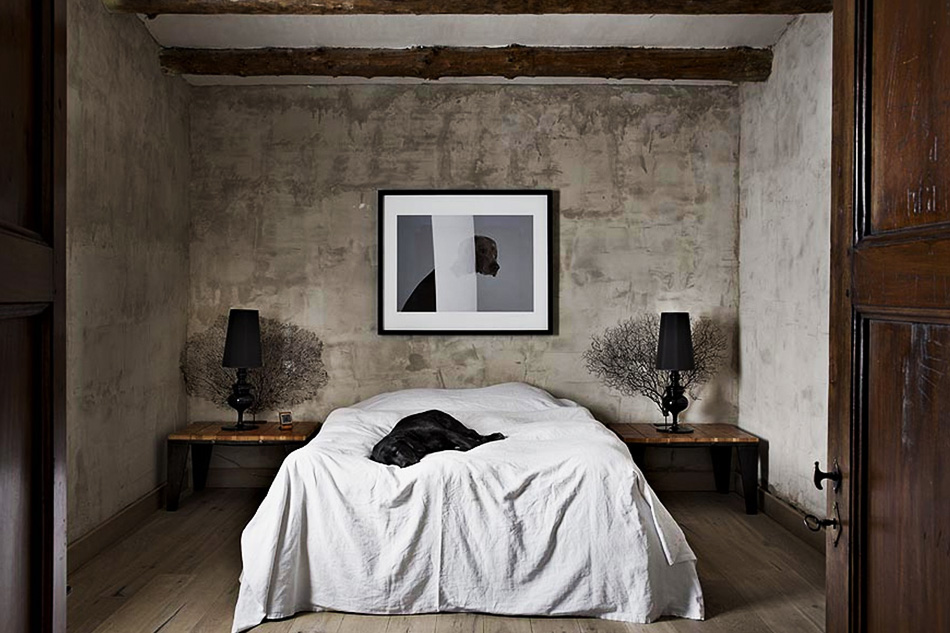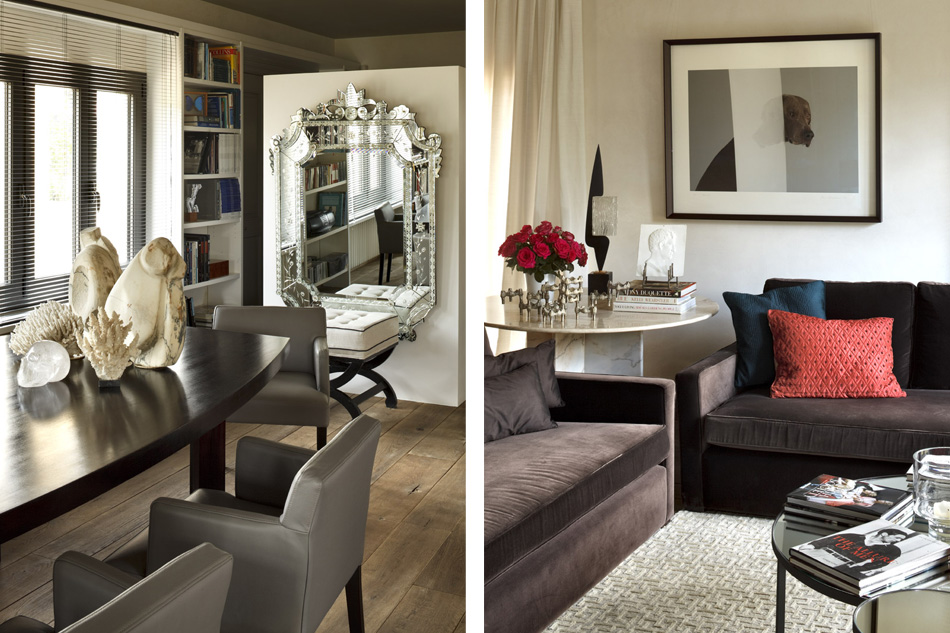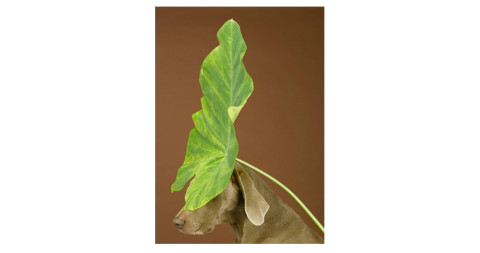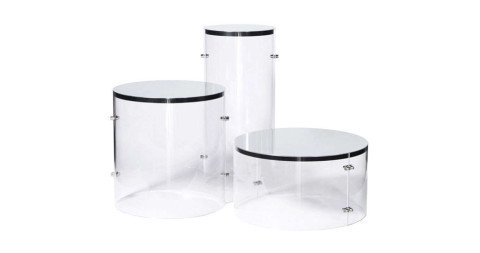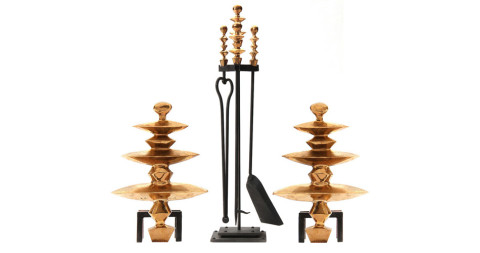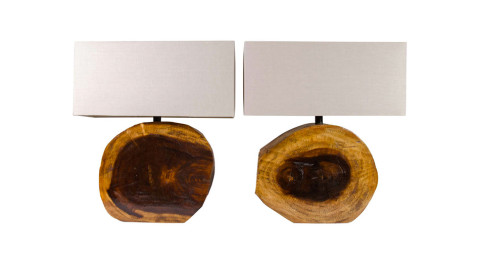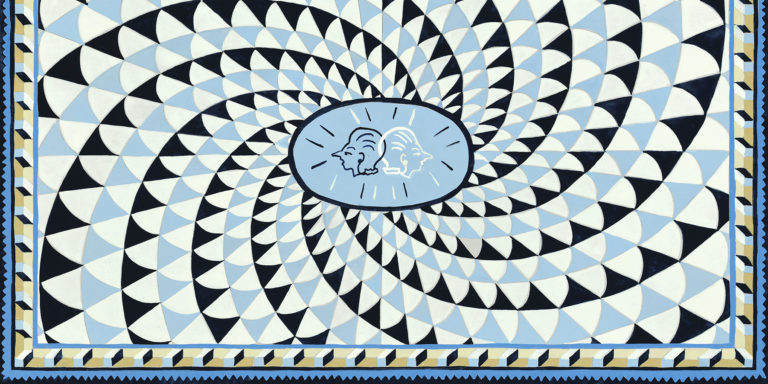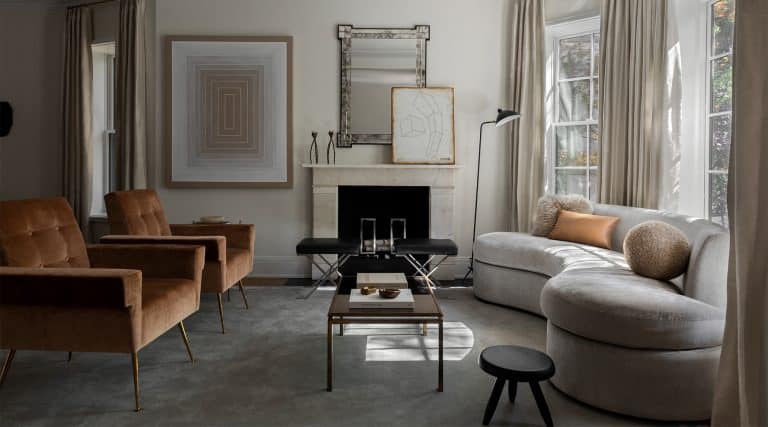
September 2013Serge Castella at his home in the Spanish countryside, which he shares with his partner, labrador retrievers and horses. Top: In the kitchen of Castella’s own home, he paired a custom-made table with iron chairs from the estate of the late fashion designer Roger Vivier. Photo by Manolo Yllera
To reach interior designer Serge Castella’s ranch in Spain’s Catalonian countryside, you have to drive through a rustic landscape of gentle hills, olive groves and vineyards, the Pyrenees rising in the distance. Only a few miles from the coast, it couldn’t be a more idyllic location. A sense of remove in a beautiful, unspoiled setting near the Mediterranean is what Castella and his partner, Jason Flinn, agreed they most wanted when they went looking several years ago for a place to live, work and breed Quarter horses and Appaloosas (a particular passion of Flinn, who hails from Vermont). And, after considering Italy and the South of France, where Castella, now 48, spent his youth, they arrived here, in Emporda, Spain. “It was love at first sight,” says the exuberant Castella when we sit down for a chat in his airy living room, sparsely furnished with a few elegant antiques. “We knew the luminous light and the unspoiled quality of the region would inspire us.”
Casually dressed in a dark-blue shirt and jeans, with a few days’ worth of beard growth, his dark wavy hair worn longish, Castella looks more like a bohemian painter than the globe-trotting interior-design rock star that he is. But Castella and Flinn’s enviable life in Emporda grew out of Castella’s long-ago decision not to let his work interfere with his love of the outdoors: He wouldn’t settle in a city just to accommodate his design and antiques businesses. As it turns out, clients love having the excuse to visit the ranch – and the duo’s three rambunctious Labradors, Foca, Choky and Amy. And for those who can’t make the two-hour trip by car from Barcelona, or points well beyond, Castella is more than happy to go to them.
As a child of the 1970s growing up in sun-drenched Perpignan, near the Spanish border, Castella dreamed of becoming a fashion designer, and after graduating from high school, he moved to Paris to attend ESMOD, a highly regarded fashion school. He went on to work for Cacharel, Christophe Lebourg and Agnès B. It wasn’t long, however, before he realized that fashion was not his life’s passion. He returned to his hometown to pursue another interest: 20th-century antiques. “I am an addict when it comes to collecting,” confesses Castella, who began amassing pieces of mid-century furniture and Art Deco French creations when he was only in his 20s.

The guest house of a Mediterranean horse farm includes a Pierre Chapo table, Maison Jansen chairs, a chandelier by Castella’s sister, Sylvie, and a ceramic sculpture by Alessandro Mendini. Photo by Pere Peris
He traveled to New York for six months to work with the much-admired antiques dealer Amy Perlin, whom Castella credits with teaching him everything he now knows about antiques. After moving back to Europe, he sold to her on a monthly basis for more than 20 years, until her death in 2010. “Serge and Amy shared a passion, an art de vivre,” says Flinn.
Not long into his time as a dealer, Castella’s clients realized his keen eye for art and antiques made him perfectly suited to design their homes. His third career thus took off, with articles on his projects soon appearing in the European and Russian editions of Architectural Digest, Elle Decor and Vogue, among others. (In addition to designing interiors, Castella still spends much of his time dealing in 20th-century antiques and, since 2000, Roman antiquities, which he sells both from his home in Spain and on 1stdibs).
Today, their design projects take Castella and Flinn – who studied architecture at the University of Copenhagen and now serves as the chief interpreter of Castella’s ideas – around the world: from a grand apartment in Moscow and a house by the sea in Tel Aviv to a 19th-century castle in France and a mansion by the bay in the Hamptons.
Though they spend nearly half of every month traveling, the pair still manages to find time every summer to vacation in upstate New York at their 19th-century Dutch cottage-style house on Lake Champlain.
The ranch in Emporda remains their anchor, however. After purchasing the 10 acre property 15 years ago, the duo decided to tear down the original farmhouse, which was architecturally unremarkable and too large for their needs. They then converted the property’s stables into a spacious and loft-like five-room residence, adding new accommodations for their horses elsewhere.
For the exterior, they decided on Mediterranean stucco, mixing the material with soil to achieve an earthy color. They choose old terra-cotta Roman tiles for the roof and sourced custom-made windows made of eco-friendly wood. They gave the living room a view onto the patio, which is surrounded by indigenous plants, olive and cypress trees, santolines and irises. “We wanted the garden to be small and structured, so as to blend in with the bountiful countryside,” explains Flinn, who, at 47, is tall and lanky with fresh-faced good looks.
“I am an addict when it comes to collecting.”

Castella’s roots as a collector often come through in his interiors, as in this tableau, which combines various natural artifacts with a watercolor by Bernard Buffet. Photo by Montse Garriga
Decorated in beiges and grays, the home’s living room and adjacent office have a relaxed and congenial atmosphere, a common denominator among all the firm’s interiors. A tight-knit team of five handles eight to ten projects a year, about a quarter of which are hotels, shops and restaurants. The team has just finished designing a new Geneva boutique for the Swiss jeweler Bogh-Art, for instance, and has recently started on its London location. A boutique hotel in Geneva and a restaurant in Hawaii are also in the works. The bulk of the work is residential, however, “for private professionals who are very successful in their fields and who want a space that rewards them for this success,” say Castella. “Normally, space, harmony and comfort – both actual and visual comfort – define this reward.”
A recurring theme in our work,” Castella continues, “is trying to attain a combined sense of elegance and comfort, and the desire to use cultural references. This can mean anything from the selected colors to furniture proportions to the juxtaposition of periods and styles.” In a glamorous contemporary house that he completed last year on Lake Geneva, Castella had the entryway painted in elephant-gray lacquer and softly lit with spotlights set into the ceiling. The only decoration is a five-foot-tall Roman sculpture of a woman. In the living room, he continued the same colors in a gray leather couch by Austrian designer Robert Stadler and a gray-and-beige carpet from the Rug Company. Taupe silk curtains hang on the tall windows, with the ceiling done in a shiny, white lacquer. Castella tries to create custom-made pieces whenever possible; about half of the furnishings in any given project are of his own design.

In the Spanish seaside home, Richard Orlinski’s Born Wild crocodile complements a Maria Pergay chrome sconce. Photo by Mark Peters
As to where these custom pieces are crafted, Castella and Flinn’s international travels have introduced them to artisans from around the world. “Our credo is to work with the best in their domain,” says Flinn. They go to Switzerland’s Art Kern for their metalwork, Madrid’s Juan and Paloma Garrido for their gold and silver furniture and London’s Rug Company for their floor coverings, to name just a few sources. A gilded-brass console by the Garridos, which resembles an Art Deco sculpture, currently adorns their own living room in Spain – but like every other object here, it will eventually end up in someone else’s home. The only constant is a William Wegman portrait of the artist’s own Weimaraner, which has hung over the couple’s bed since they moved in.
Five years ago, Castella and Flinn expanded their art interests from collecting to exhibiting, holding annual summer shows of art and sometimes furniture on their Spanish property. They organize them in conjunction with the presentation of their recent art and design purchases. And this May, they held their first exhibition at 1stdibs’ gallery at the New York Design Center, presenting watercolors from the 1950s and ’60s by the late American Abstract Expressionist Jacob Semiatin, whose estate they recently purchased. Next month, it will travel to Galeria Miguel Alzueta, in Barcelona, before continuing to galleries in Geneva and Tel Aviv. “We found that combining an art show with furniture allowed clients to better project themselves into an environment suitable for the artwork,” Flinn says.
Castella may be French but he considers his work to be international. Although he carries influences from his French roots, such as his striving for balance and harmony and his classical base, an even larger influence comes from today’s modern, global world. “If our style has changed over the years it’s because our clients are giving us more and more liberty and confidence,” he says. “We work to create environments that are harmonious and enjoyable, regardless of the style – urban, country, Mediterranean or anything else. It’s how we live and we imagine it’s the way most people would like to live, too.”
Serge Castella’s Quick Picks on 1stdibs

